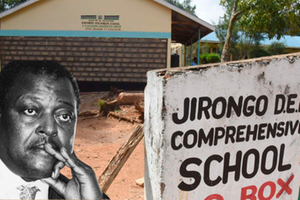Premium
Fuel consumption drops as high pump prices bite

An attendant fuels a motor vehicle at OLA petrol station near Pandya Hospital in Mombasa County on July 1, 2023. Fuel consumption has dropped to the lowest level in at least five years.
What you need to know:
- Major losers of the dip includes KRA whose collections from petroleum taxes, levies have been hit.
- Decline comes amid increased taxes that negated benefits of fall in global prices.
Fuel consumption between July and September plunged to the lowest level in at least five years, with the decline coming amid increased taxation that negated the benefits of a drop in global prices, with local pump prices crossing the Sh200 mark for the first time.
Analysis of official data shows that diesel consumption dipped 4.3 per cent to 658.09 million litres in the review period from 687.66 million litres a year earlier while that of super petrol fell to 497.46 million litres from 499.54 million litres.
Kenya doubled Value Added Tax (VAT) on fuel to 16 per cent from July 1, which made the petroleum products costlier and suppressed demand.
Major losers of the dip in consumption include Kenya Revenue Authority whose collections from petroleum taxes and levies were hit, given that the amount raised mirrors sales volumes of fuel.
“Oil revenue recorded a performance rate of 84.8 per cent in July-September 2023 for a deficit of Sh12.9 billion against target and a decline of 8.6 per cent over July-September 2022 collections,” KRA said in its review of the revenue performance.
Diesel is the dominant fuel for public transport service providers and powering agricultural machinery such as tractors and harvesters. Thermal power plants also use the fuel to generate electricity.
Murban crude prices dropped to $75.6 (Sh11,264) per barrel in August from $84.11 (Sh12,152) in June, in what could have led to a drop in local pump prices had Parliament not doubled VAT from eight per cent.
The last time consumption was lower than this year was 674.46 million litres for diesel between July and September 2019 and 493.83 million litres for super petrol between July and September 2020.
Consumption of kerosene between July and September this year dropped to 15.29 million litres from 28.75 million litres in the same period last year. This year’s consumption is the lowest in at least five years.
A litre of super petrol jumped by Sh13.49 to Sh195.53 while that of diesel rose by Sh12.39 to Sh179.67 from July 1 on the doubled VAT and global rise in prices of fuel.
The prices remained on a steady jump and hit Sh211.64 per litre of super petrol while diesel hit Sh200.9 a litre in September — marking the first time the prices crossed the Sh200 mark.
The rise prompted the government to reinstate the fuel stabilisation kitty amid mounting public outrage over costly fuel and its impact on the cost of living.
Currently, a litre of super petrol is retailing at Sh217.36 while that of diesel is going for Sh203.47 in Nairobi despite application of the subsidy. A litre of kerosene is retailing at Sh203.06.
Consumption of diesel and kerosene for the period between July and September this year is significantly lower than a similar period in 2020 when restrictions imposed to curb spread of the Coronavirus hit demand.





